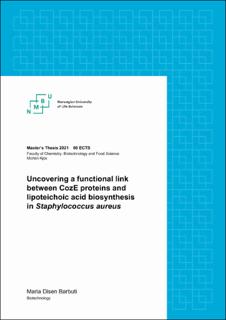| dc.contributor.advisor | Kjos, Morten | |
| dc.contributor.advisor | Straume, Daniel | |
| dc.contributor.author | Barbuti, Maria Disen | |
| dc.date.accessioned | 2021-07-05T11:51:37Z | |
| dc.date.available | 2021-07-05T11:51:37Z | |
| dc.date.issued | 2021 | |
| dc.identifier.uri | https://hdl.handle.net/11250/2763397 | |
| dc.description.abstract | Staphylococcus aureus is a common and successful human pathogen. Infections caused by S aureus have become an urgent challenge in nosocomial and community settings, due to their multiple virulence mechanisms and ability to rapidly evolve resistance to novel antibiotics. Development of new therapeutic approaches to counteract the emergence of (multi) antibiotic resistant S. aureus strains is critical. Antibiotics that target bacterial cell division and teichoic acid biosynthesis has garnered interest in recent years. However, staphylococcal cell division is still not fully understood. In a previous study, the so-called CozE proteins found in S. aureus, CozEa and CozEb, have been demonstrated to play an important role in proper cell division, but the molecular mode of action by which the CozE proteins work are unknown.
In this work, the cellular functions of the CozE proteins were investigated further. Construction and characterisation of single and double cozE mutants confirmed that cozEa and cozEb constitute a synthetic lethal gene pair in S. aureus. Based on these results, we hypothesised that CozEa and CozEb possibly had a link to biosynthesis of lipoteichoic acids (LTAs) in S. aureus. By constructing a panel of mutant strains with knockdown of the cozE genes and LTA synthesis/modification genes, followed by growth assays, phase contrast- and transmission electron microscopy, we uncovered that two LTA biosynthesis genes (ugtP and ltaA) have pairwise synthetic genetic interactions with the cozE genes. Knockdown of cozEa and cozEb together is detrimental to wild-type S. aureus cells, and knockdown of these genes in a ΔugtP background perpetuated the cell lysis phenotype observed in wild-type background. On the other hand, knockdown of both cozE genes in ΔltaA background did remarkably not result in any apparent alterations to their growth rate or morphology. Normal cell growth and cell division were re-established in these ΔltaA mutant strains. Anti-LTA immunoblot assays with cell lysates from the different mutants revealed that CozEb play a unique role in controlling LTA polymer length. S. aureus ΔcozEb mutants displayed abnormally long LTA polymers, reminiscent of LTA found in mutants affecting LTA glycolipid anchor synthesis (ΔugtP and ΔltaA). Subcellular localisation analysis by fluorescence microscopy of these proteins were also performed. Together, the results obtained in this work clearly demonstrates a functional link between CozE proteins and LTA biosynthesis in S. aureus, and the CozE proteins are predicted to perform this function upstream of either UgtP or LtaA. | en_US |
| dc.description.abstract | Staphylococcus aureus er en vanlig og vellykket human patogen. Infeksjoner forårsaket av S. aureus er en økende utfordring, både i helseinstitusjoner og utenfor, på grunn av deres mangfoldige virulensmekanismer og evne til å utvikle motstandsdyktighet mot nye antibiotika. Utvikling av nye behandlingsmetoder for å motvirke fremveksten av (multi)resistente S. aureus-stammer er svært viktig. Forskere har vist økt interesse for antibiotika som angriper bakteriell celledeling og biosyntese av teikoinsyre de siste årene. Celledelingen hos stafylokokker er imidlertid ikke fullstendig forstått enda. I en tidligere studie har de såkalte CozE-proteinene i S. aureus, CozEa og CozEb, vist seg å spille en viktig rolle i celledeling, men den molekylære virkningsmåten til disse proteinene er ukjent. I dette arbeidet ble funksjonene til CozE-proteinene undersøkt nærmere. Konstruksjon og karakterisering av enkle og doble cozE-mutanter, bekreftet at cozEa og cozEb utgjør et syntetisk letalt genpar i S. aureus. Basert på disse resultatene, formulerte vi en hypotese om at CozEa og CozEb muligens hadde en kobling til biosyntese av lipoteikoinsyrer (LTAer) i S. aureus. Ved å konstruere et panel av mutanter med «knock-down» av cozE-genene og LTAsyntese/modifikasjonsgener, etterfulgt av vekstanalyser, fasekontrast- og transmisjonselektronmikroskopi, avdekket vi at to LTA-syntesegener (ugtP og ltaA) har syntetiske genetiske interaksjoner med cozE-genene. «Knock-down» av cozEa og cozEb sammen er svært skadelig for S. aureus celler, og «knock-down» av disse genene i en ΔugtP bakgrunn forsterket cellelysis-fenotypen observert i villtype bakgrunnen. Derimot «knockdown» av begge cozE-genene i ΔltaA bakgrunn resulterte tilsynelatende ikke i endringer i vekst eller morfologi. Normal cellevekst og -deling ble gjenopprettet i disse ΔltaA mutantene. Anti-LTA immunoblot-analyser med cellelysat fra de forskjellige mutantene avslørte i tillegg at CozEb spiller en unik rolle når det kommer til å kontrollere lengden på LTA-polymerer. S. aureus ΔcozEb-mutanter produserte unormalt lange LTA-polymerer, som minner om LTAene man finner i mutanter med forstyrret LTA glykolipidanker-syntese (ΔugtP og ΔltaA). Subcellulære lokaliseringsanalyser, ved bruk av fluorescensmikroskopi, ble også foretatt med disse proteinene. I sum viser resultatene i dette arbeidet tydelig tilstedeværelsen av en funksjonell kobling mellom CozE-proteiner og LTA-biosyntese i S. aureus, og CozEproteinene ser ut til å utføre denne funksjonen oppstrøms for enten UgtP eller LtaA. | en_US |
| dc.language.iso | eng | en_US |
| dc.publisher | Norwegian University of Life Sciences, Ås | en_US |
| dc.rights | Attribution-NonCommercial-NoDerivatives 4.0 Internasjonal | * |
| dc.rights.uri | http://creativecommons.org/licenses/by-nc-nd/4.0/deed.no | * |
| dc.title | Uncovering a functional link between CozE proteins and lipoteichoic acid biosynthesis in Staphylococcus aureus | en_US |
| dc.type | Master thesis | en_US |
| dc.description.localcode | M-BIOTEK | en_US |

